Unravelling the Effects of Soluble Dietary Fibre Supplementation on Energy Intake and Perceived Satiety in Healthy Adults: Evidence from Systematic Review and Meta-Analysis of Randomised-Controlled Trials
Abstract
1. Introduction
2. Methods
2.1. Eligibility Criteria
2.2. Search Strategy
2.3. Data Management and Analysis
2.4. Evaluation of Studies and Data Synthesis
3. Results
3.1. Study Selection
3.2. Study Characteristics
3.3. Outcome Measures
3.4. Risk of Bias within Studies Based on Jadad Score
3.5. Random Effects Analysis
3.6. Fixed Effects Analysis
4. Discussion
5. Conclusions
Author Contributions
Funding
Acknowledgments
Conflicts of Interest
References
- Mann, J.I.; Cummings, J.H. Possible implications for health of the different definitions of dietary fibre. Nutr. Metab. Cadiovasc. Dis. 2009, 19, 226–229. [Google Scholar] [CrossRef] [PubMed]
- Sullivan, D.M.; Carpenter, D.E. Methods of Analysis for Nutrition Labelling; AOAC International: Arlington, VA, USA, 1993; p. 624. ISBN 0935584528. [Google Scholar]
- Kristensen, M.; Jensen, M.G. Dietary fibres in the regulation of appetite and food intake. Importance of viscosity. Appetite 2011, 56, 65–70. [Google Scholar] [CrossRef] [PubMed]
- Jenkins, D.J.; Wolever, T.M.; Leeds, A.R.; Gassull, M.A.; Haisman, P.; Dilawari, J.; Goff, D.V.; Metz, G.L.; Alberti, K.G. Dietary fibres, fibre analogues and glucose tolerance: Importance of viscosity. Br. Med. J. 1978, 1, 1392–1394. [Google Scholar] [CrossRef] [PubMed]
- Wood, P.J.; Braaten, J.T.; Scott, F.W.; Riedel, K.D.; Wolynetz, M.S.; Collins, M.W. Effects of dose and modification of viscous properties of oat gum on plasma and insulin following an oral glucose load. Br. J. Nutr. 1994, 72, 731. [Google Scholar] [CrossRef] [PubMed]
- Wong, J.M.; de Souza, R.; Kendall, C.W.; Emam, A.; Jenkins, D.J. Colonic health: Fermentation and short chain fatty acids. J. Clin. Gastroenterol. 2006, 40, 235–243. [Google Scholar] [CrossRef] [PubMed]
- Macfarlene, S.; Macfarlene, G.T.; Cummings, J.H. Review article: Prebiotics in the gastrointestinal tract. Aliment. Pharmacol. Ther. 2006, 24, 701–714. [Google Scholar] [CrossRef] [PubMed]
- Roberfroid, M.B. Inulin-type fructans: Functional food ingredients. J. Nutr. 2007, 137, 249–250. [Google Scholar] [CrossRef]
- Dikeman, C.L.; Murphy, M.R.; Fahey, G.C. Dietary fibers affect viscosity of solutions and simulated human gastic and small intestinal digesta. J. Nutr. 2006, 136, 913–919. [Google Scholar] [CrossRef]
- Dikeman, C.L.; Fahey, G.C. Viscosity as related to dietary fiber: A review. Crit. Rev. Food. Sci. Nutr. 2006, 46, 649–663. [Google Scholar] [CrossRef]
- Braaten, J.T.; Wood, P.J.; Scott, F.W.; Riedel, K.D.; Poste, L.M.; Collins, M.W. Oat gum lowers glucose and insulin after an oral glucose load. Am. J. Clin. Nutr. 1991, 53, 1425–1430. [Google Scholar] [CrossRef]
- Marciani, L.; Gowland, P.A.; Spiller, R.C.; Manoj, P.; Moore, R.J.; Young, P.; Fillery-Travis, A.J. Effect of meal viscosity and nutrient on satiety, intragastric dilution and emptying assessed by MRI. Am. J. Physiol. Gastrointest. Liver Physiol. 2001, 280, 1227–1233. [Google Scholar] [CrossRef] [PubMed]
- Darwiche, G.; Björgell, O.; Almér, L.-O. The addition of locust bean gum but not water delayed the gastric emptying rate of a nutrient semisolid meal in healthy subjects. BMC Gastroenterol. 2003, 3, 12. [Google Scholar] [CrossRef] [PubMed]
- Edwards, C.A.; Johnson, I.T.; Read, N.W. Do viscous polysaccharides slow absorption by inhibiting diffusion or convection? Eur. J. Clin. Nutr. 1988, 42, 307–312. [Google Scholar] [PubMed]
- Schneeman, B.O.; Gallaher, D. Effects of dietary fiber on digestive enzyme activity and bile acids in the small intestine. Proc. Soc. Exp. Biol. Med. 1985, 180, 409–412. [Google Scholar] [CrossRef] [PubMed]
- Eastwood, M.A.; Morris, E.R. Physical properties of dietary fiber that influence physiological function: A model for polymers along the gastrointestinal tract. Am. J. Clin. Nutr. 1992, 55, 436–442. [Google Scholar] [CrossRef] [PubMed]
- Delzenne, N.M.; Cani, P.D.; Daubioul, C.; Neyrinck, A.M. Impact of inulin and oligofructose on gastrointestinal peptides. Br. J. Nutr. 2005, 93, 157–161. [Google Scholar] [CrossRef]
- Keenan, M.J.; Zhou, J.; McCutcheon, K.L.; Raggio, A.M.; Bateman, H.G.; Todd, E.; Jones, C.K.; Tulley, R.T.; Melton, S.; Martin, R.J.; et al. Effects of resistant starch, a non-digestible fermentable fiber on reducing body fat. Obesity 2006, 14, 1523–1534. [Google Scholar] [CrossRef] [PubMed]
- Reimer, R.A.; McBurney, M.I. Dietary fiber modulates intestinal proglucagon messenger ribonucleic acid and postprandial secretion of glucagon-like peptide-1 and insulin in rats. Endocrinology 1996, 137, 3948–3956. [Google Scholar] [CrossRef]
- Dumoulin, V.; Moro, F.; Barcelo, A.; Dakka, T.; Cuber, J.C. Peptide YY, glucagon-like peptide-1 and neurotensin responses to luminal factors in the isolated vascularly perfused rat ileum. Endocrinology 1998, 139, 3780–3786. [Google Scholar] [CrossRef]
- Gibson, G.R.; Probert, H.M.; Loo, J.V.; Rastall, R.A.; Roberfroid, M.B. Dietary modulation of the human colonic microbiota: Updating the concept of prebiotics. Nutr. Res. Rev. 2004, 17, 259–275. [Google Scholar] [CrossRef]
- Douglas, L.C.; Sanders, M.E. Probiotics and prebiotics in dietetics practice. J. Am. Diet. Assoc. 2008, 108, 510–521. [Google Scholar] [CrossRef] [PubMed]
- Blundell, J.; De Graaf, C.; Hulshof, T.; Jebb, S.; Livingstone, B.; Lluch, A.; Mela, D.; Salah, S.; Schuring, E.; Knaap, H.V.D.; et al. Appetite control: Methodological aspects of the evaluation of foods Europe PMC Funders Group. Obes. Rev. 2010, 11, 251–270. [Google Scholar] [CrossRef] [PubMed]
- Lyly, M.; Ohls, N.; Lähteenmäki, L.; Salmenkallio-Marttila, M.; Liukkonen, K.-H.; Karhunen, L.; Poutanen, K. The effect of fibre amount, energy level and viscosity of beverage containing oat fibre supplement on perceived satiety. Food Nutr. Res. 2010, 54. [Google Scholar] [CrossRef] [PubMed]
- Burkus, Z.; Temelli, F. Quantitative determination of β-glucan content. Curr. Protoc. Food Anal. Chem. 2003, 7, E3.5.1–E3.5.12. [Google Scholar] [CrossRef]
- World Health Organization. Obesity: Preventing and Managing the Global Epidemic; World Health Organization: Geneva, Switzerland, 2000; pp. 1–268. [Google Scholar] [CrossRef]
- West, S.L.; Gartlehner, G.; Mansfield, A.J.; Poole, C.; Tant, E.; Lenfestey, N.; Lux, L.J.; Amoozegar, J.; Morton, S.C.; Carey, T.C.; et al. Comparative Effectiveness Review Methods: Clinical Heterogeneity; Agency for Healthcare Research and Quality: Rockville, MD, USA, 2010.
- Guyatt, G.; Rennie, D.; Meade, M.O.; Cook, D.J. Users’ Guides to Themedical Literature, 2nd ed.; McGraw Hill Medical: New York, NY, USA, 2008. [Google Scholar]
- O’Connor, D.; Green, S.; Higgin, J.P. Defining the review question and developing criteria for including studies. In Cochrane Handbook for Systematic Reviews of Interventions; John Wiley & Sons, Ltd.: Chichester, UK, 2008; pp. 81–94. ISBN 97080470699515. [Google Scholar]
- Borenstein, M.; Hedges, L.V.; Higgins, J.P.T.; Rothstein, H.R. Effect sizes based on means. In Introduction to Meta-Analysis, 1st ed.; John Wiley & Sons, Ltd.: Chichester, UK, 2009; pp. 21–32. ISBN 9780470743386. [Google Scholar]
- LeBlanc, D.C. Statistics: Concepts and Application for Science; Jones and Barlette: Burlington, MA, USA, 2004; p. 382. ISBN 0763746991. [Google Scholar]
- Neyeloff, J.L.; Fuchs, S.C.; Moreira, L.B. Meta-analyses and forest plots using a Microsoft excel spreadsheet: Step-by-step guide focusing on descriptive data analysis. BMC Res. Notes 2012, 5, 52. [Google Scholar] [CrossRef] [PubMed]
- Higgins, J.P.T.; Thompson, S.G.; Deeks, J.J.; Altman, D.G. Measuring inconsistency in meta-analyses Testing for heterogeneity. BMJ 2003, 327, 557–560. [Google Scholar] [CrossRef] [PubMed]
- Jadad, A.R.; Moore, R.A.; Carroll, D.; Jenkinson, C.; Reynolds, D.J.; Gavaghan, D.J.; McQuay, H.J. Assessing the quality of reports of randomized clinical trials: Is blinding necessary? Control. Clin. Trials 1996, 17, 1–12. [Google Scholar] [CrossRef]
- Arshad, M.U.; Ishtiaq, S.; Anjum, F.M.; Saeed, F.; Chatha, S.A.S.; Imran, A. Acute effects of different dietary polysaccharides added in milk on food intake, postprandial appetite and glycemic responses in healthy young females. Int. J. Food Sci. Nutr. 2016, 67. [Google Scholar] [CrossRef]
- Wanders, A.J.; Jonathan, M.C.; Van Den Borne, J.J.G.C.; Mars, M.; Schols, H.A.; Fesken, E.J.M.; De Graaf, C. The effects of bulking, viscous and gel-forming dietary fibres on satiation. Br. J. Nutr. 2013, 109, 1330–1337. [Google Scholar] [CrossRef]
- Rao, T.P.; Hayakawa, M.; Minami, T.; Ishihara, N.; Kapoor, M.P.; Ohkubo, T.; Juneja, L.R.; Wakabayashi, K. Post-meal perceivable satiety and subsequent energy intake with intake of partially hydrolysed guar gum. Br. J. Nutr. 2015, 113, 1489–1498. [Google Scholar] [CrossRef]
- Aoe, S.; Ikenaga, T.; Noguchi, H.; Kohashi, C.; Kakumoto, K.; Kohda, N. Effect of cooked white rice with high β-glucan barley on appetite and energy intake in healthy Japanese subjects: A randomized controlled trial. Plant Foods Hum. Nutr. 2014, 69, 325–330. [Google Scholar] [CrossRef] [PubMed]
- Lumaga, B.; Azzali, R.; Fogliona, V.; Scalfi, L.; Vitaglione, P. Sugar and dietary fibre composition influence, by different hormonal response, the satiating capacity of a fruit-based and a β-glucan-enriched beverage. Food Funct. 2012, 3, 67–75. [Google Scholar] [CrossRef] [PubMed]
- Wanders, A.J.; Fesken, E.J.M.; Jonathan, M.C.; Schol, H.A.; de Graaf, C.; Mars, M. Pectin is not pectin: A randomized trial on the effect of different physicochemical properties of dietary fiber on appetite and energy intake. Physiol. Behav. 2014, 128, 212–219. [Google Scholar] [CrossRef] [PubMed]
- Martinelli, M.; Walz, F.; Goñi, E.; Passutti, G.; Osella, C.; Drago, S.R. Effects of puddings containing whey protein and polydextrose on subjective feelings of appetite and and short-term energy intake in healthy adults. Int. J. Food Sci. Nutr. 2017, 68, 733–741. [Google Scholar] [CrossRef] [PubMed]
- Astbury, N.M.; Taylor, M.A.; MacDonald, I.A. Polydextrose results in a dose-dependent reduction in ad libitum energy intake at a subsequent test meal. Br. J. Nutr. 2013, 110, 934–942. [Google Scholar] [CrossRef]
- Soong, Y.Y.; Lim, W.X.; Leow, M.K.S.; Siow, P.C.; Teh, A.L.; Henry, C.J. Combination of soya protein and polydextrose reduces energy intake and glycemic response via modulation of gastric emptying rate, ghrelin and glucagon-like peptide-1 in Chinese. Br. J. Nutr. 2016, 115, 2130–2137. [Google Scholar] [CrossRef]
- Hull, S.; Re, R.; Tiihonen, K.; Viscione, L.; Wickham, M. Consuming polydextrose in a mid-morning snack increases acute satiety measurements and reduces subsequent energy intake at lunch in healthy human subjects. Appetite 2012, 59, 706–712. [Google Scholar] [CrossRef]
- Juvonen, K.R.; Purhonen, A.-K.; Salmenkallio-Marttila, M.; Lahteenmaki, L.; Laaksonen, D.E.; Herzig, K.-H.; Uusitupa, M.I.J.; Poutanen, K.S.; Karhunen, L.J. Viscosity of oat bran-enriched beverages influences gastrointestinal hormonal responses in healthy humans. J. Nutr. 2009, 139, 461–466. [Google Scholar] [CrossRef]
- Boll, E.V.J.; Ekström, L.M.N.K.; Courtin, C.M.; Delcour, J.A.; Nilsson, A.C.; Björck, I.M.E.; Östman, E.M. Effects of wheat bran extract rich in arabinoxylan oligosaccharides and resistant starch on overnight glucose tolerance and markers of gut fermentation in healthy young adults. Eur. J. Nutr. 2016, 55, 1661–1670. [Google Scholar] [CrossRef]
- Thazhath, S.S.; Wu, T.; Bound, M.J.; Checklin, H.L.; Jones, K.L.; Willoughby, S.; Horowitz, M.; Rayner, C.K. Changes in meal composition and duration affect postprandial endothelial function in healthy humans. Am. J. Physiol.-Gastrointest. Liver Physiol. 2014, 307. [Google Scholar] [CrossRef]
- Luhovyy, B.L.; Mollard, R.C.; Yurchenko, S.; Nunez, M.F.; Berengut, S.; Liu, T.T.; Smith, C.E.; Pelkman, C.L.; Anderson, G.H. The effects of whole grain high-amylose maize flour as a source of resistant starch on blood glucose, satiety and food intake in young men. J. Food Sci. 2014, 79, 2550–2556. [Google Scholar] [CrossRef] [PubMed]
- Solah, V.A.; Brand-Miller, J.C.; Atkinson, F.S.; Gahler, R.J.; Kacinik, V.; Lyon, M.R.; Wood, S. Dose-response effect of a novel functional fibre, PolyglycopleX®, PGX®, on satiety. Appetite 2014, 77, 72–76. [Google Scholar] [CrossRef] [PubMed]
- Gacesa, P. Alginates. Carbohydr. Polym. 1988, 8, 161–182. [Google Scholar] [CrossRef]
- Aps, J.K.M.; Martens, L.C. Review: The physiology of saliva and transfer of drugs into saliva. Forensic Sci. Int. 2005, 150, 119–131. [Google Scholar] [CrossRef]
- Dickinson, E. Interfacial structure and stability of food emulsions as affected by protein-polysaccharide interactions. Soft Matter 2008, 4, 932–942. [Google Scholar] [CrossRef]
- Mattes, R.D.; Rothacker, D. Beverage viscosity is inversely related to postprandial hunger in humans. Physiol. Behav. 2001, 74, 551–557. [Google Scholar] [CrossRef]
- Yoon, S.J.; Chu, D.C.; Juneja, L.R. Chemical and physical properties, safety and application of partially hydrolyzed guar gum as dietary fiber. J. Clin. Biochem. Nutr. 2008, 42, 1–7. [Google Scholar] [CrossRef] [PubMed]
- Ellis, P.R.; Dawoud, F.M.; Morris, E.R. Blood glucose, plasma insulin and sensory responses to guar-containing wheat breads: Effects of molecular weight and particle size of guar gum. Br. J. Nutr. 1991, 66, 363–379. [Google Scholar] [CrossRef]
- Thakur, B.R.; Singh, R.K.; Handa, A.K. Chemistry and uses of pectin—A review. Crit. Rev. Food Sci. Nutr. 1997, 37, 47–73. [Google Scholar] [CrossRef]
- Vuksan, V.; Panahai, S.; Lyon, M.; Rogovik, A.L.; Leiter, L.A. Viscosity of fiber preloads affects food intake in adolescents. Nutr. Metab. Cardiovasc. Dis. 2009, 19, 498–503. [Google Scholar] [CrossRef]
- Ellis, P.R.; Morris, E.R. Importance of the rate of hydration of pharmaceutical preparations of guar gum; a new in vitro monitoring method. Diabet. Med. 1991, 8, 378–381. [Google Scholar] [CrossRef] [PubMed]
- Blackwood, A.D.; Salter, J.; Dettmar, P.W.; Chaplin, M.F. Dietary fibre, physicochemical properties and their relationship to health. J. R. Soc. Promot. Health 2000, 120, 242–247. [Google Scholar] [CrossRef] [PubMed]
- Slavin, J.L. Dietary fiber and body weight. Nutrition 2005, 21, 411–418. [Google Scholar] [CrossRef] [PubMed]
- European Food Safety Authority. Scientific Opinion on the substantiation of health claims related to beta-glucans from oats and barley and maintenance of normal blood LDL-cholesterol concentrations, increase in satiety leading to a reduction in energy intake. EFSA J. 2011, 9, 2207. [Google Scholar] [CrossRef]
- El Khoury, D.; Cuda, C.; Luhovyy, B.L.; Anderson, G.H. Beta glucan: Health benefits in obesity and metabolic syndrome. J. Nutr. Metab. 2011, 2012. [Google Scholar] [CrossRef] [PubMed]
- Amin, T.; Mercer, J.G. Hunger and satiety mechanisms and their potential exploitation in the regulation of food intake. Curr. Obes. Rep. 2016, 5, 106–112. [Google Scholar] [CrossRef]
- Rolls, B.J. The relationship between dietary energy density and energy intake. Physiol. Behav. 2009, 97, 609–615. [Google Scholar] [CrossRef]
- Lazaridou, A.; Biliaderi, C.G.; Izydorczyk, M.S. Cereal beta-glucans: Structures, physical properties, and physiological functions. In Function Food Carbohydrates; CRC Press: Boca Raton, FL, USA, 2007; pp. 1–72. ISBN 9780849318221. [Google Scholar]
- Beer, M.U.; Wood, P.J.; Weisz, J. Molecular weight distribution and (1-3)(1-4)-β-glucan content of consecutive extracts of various oat and barley cultivars. Cereal Chem. J. 1997, 74, 479–480. [Google Scholar] [CrossRef]
- Kirkmeyer, S.V.; Mattes, R.D. Effects of food attributes on hunger and food intake. Int. J. Obes. Relat. Metab. Disord. 2000, 24, 1167–1175. [Google Scholar] [CrossRef]
- De Graaf, C.; Blom, W.A.; Smeets, P.A.; Stafleu, A.; Hendriks, H.F. Biomarkers of satiation and satiety. Am. J. Clin. Nutr. 2004, 79, 946–961. [Google Scholar] [CrossRef]
- Lyly, M.; Liukkonen, K.-H.; Salmenkallio-Marttila, M.; Karhunen, L.; Poutanen, K.; Lähteenmäki, L. Fibre in beverages can enhance perceived satiety. Eur. J. Nutr. 2009, 48, 251–258. [Google Scholar] [CrossRef] [PubMed]
- Coppari, R.; Elmquist, J.K. Neuroendocrine control of energy balance (Central Circuits/Mechanisms). In Encyclopedia of Neuroscience; Elsevier Ltd.: Amsterdam, The Netherlands, 2010; pp. 327–332. ISBN 9780080450469. [Google Scholar]
- Lee, J.; Lee, J.; Shin, H.; Kim, K.S.; Lee, E.; Koh, B.; Jang, H.J. Suggestion of new possibilities in approaching individual variability in appetite through constitutional typology: A pilot study. BMC Complement. Altern. Med. 2012, 12, 122. [Google Scholar] [CrossRef] [PubMed]
- Chen, F.; Yu, Y.; Wang, P.; Dong, Y.; Wang, T.; Zuo, X.; Li, Y. Brain-derived neurotrophic factor accelerates gut motility in slow-transit constipation. Acta Physiol. 2014, 212, 226–238. [Google Scholar] [CrossRef] [PubMed]
- Howarth, N.C.; Saltzman, E.; Roberts, S.B. Dietary fiber and weight regulation. Nutr. Rev. 2001, 59, 129–139. [Google Scholar] [CrossRef] [PubMed]
- Burley, V.J.; Paul, A.W.; Blundell, J.E. Influence of a high-fibre food (myco-protein) on appetite: Effects on satiation (within meals) and satiety (following meals). Eur. J. Clin. Nutr. 1993, 47, 409–418. [Google Scholar] [PubMed]
- Raninen, K.; Lappi, J.; Mykkänen, H.; Poutanen, K. Dietary fiber type reflects physiological functionality: Comparison of grain fiber, inulin and polydextrose. Nutr. Rev. 2011, 69, 9–21. [Google Scholar] [CrossRef] [PubMed]
- Achour, L.; Flourié, B.; Briet, F.; Pellier, P.; Marteau, P.; Rambaud, J.C. Gastrointestinal effects and energy value of polydextrose in healthy nonobese men. Am. J. Clin. Nutr. 1994, 59, 1362–1368. [Google Scholar] [CrossRef] [PubMed]
- Figdor, S.K.; Bianchine, J.R. Caloric utilization and disposition of (14C) polydextrose in man. J. Agric. Food Chem. 1983, 31, 389–393. [Google Scholar] [CrossRef]
- Flood, M.T.; Auerbach, M.H.; Craig, S.A.S. A review of the clinical toleration studies of polydextrose in food. Food Chem. Toxicol. 2004, 42, 1531–1542. [Google Scholar] [CrossRef]
- Jie, Z.; Bang-Yao, L.; Ming-jie, X.; Hai-wei, L.; Zu-kang, Z.; Ting-song, W.; Craig, S.A. Studies on the effects of polydextrose intake on physiologic functions in Chinese people. Am. J. Clin. Nutr. 2000, 72, 1503–1509. [Google Scholar] [CrossRef]
- Holt, S.; Heading, R.C.; Carter, D.C.; Prescott, L.F.; Tothill, P. Effect of gel fibre on gastric emptying and absorption of glucose and paracetamol. Lancet 1979, 1, 636–639. [Google Scholar] [CrossRef]
- Powley, T.L.; Phillips, R.J. Gastric satiation is volumetric, intestinal satiation is nutritive. Physiol. Behav. 2004, 82, 69–74. [Google Scholar] [CrossRef] [PubMed]
- Nauck, M.A.; Niedereichholz, U.; Ettler, R.; Holst, J.J.; Orskov, C.; Ritsel, R.; Schmiegel, W.H. Glucagon-like-peptide 1 inhibition of gastric emptying outweighs its insulinotropic effects in healthy humans. Am. J. Physiol. 1997, 273, E981–E988. [Google Scholar] [CrossRef] [PubMed]
- Näslund, E.; Gutniak, M.; Skogar, S.; Rössner, S.; Hellström, P.M. Glucagon-like-peptide 1 increases the period of postprandial satiety and slows gastric emptying in obese men. Am. J. Clin. Nutr. 1998, 68, 525–530. [Google Scholar] [CrossRef] [PubMed]
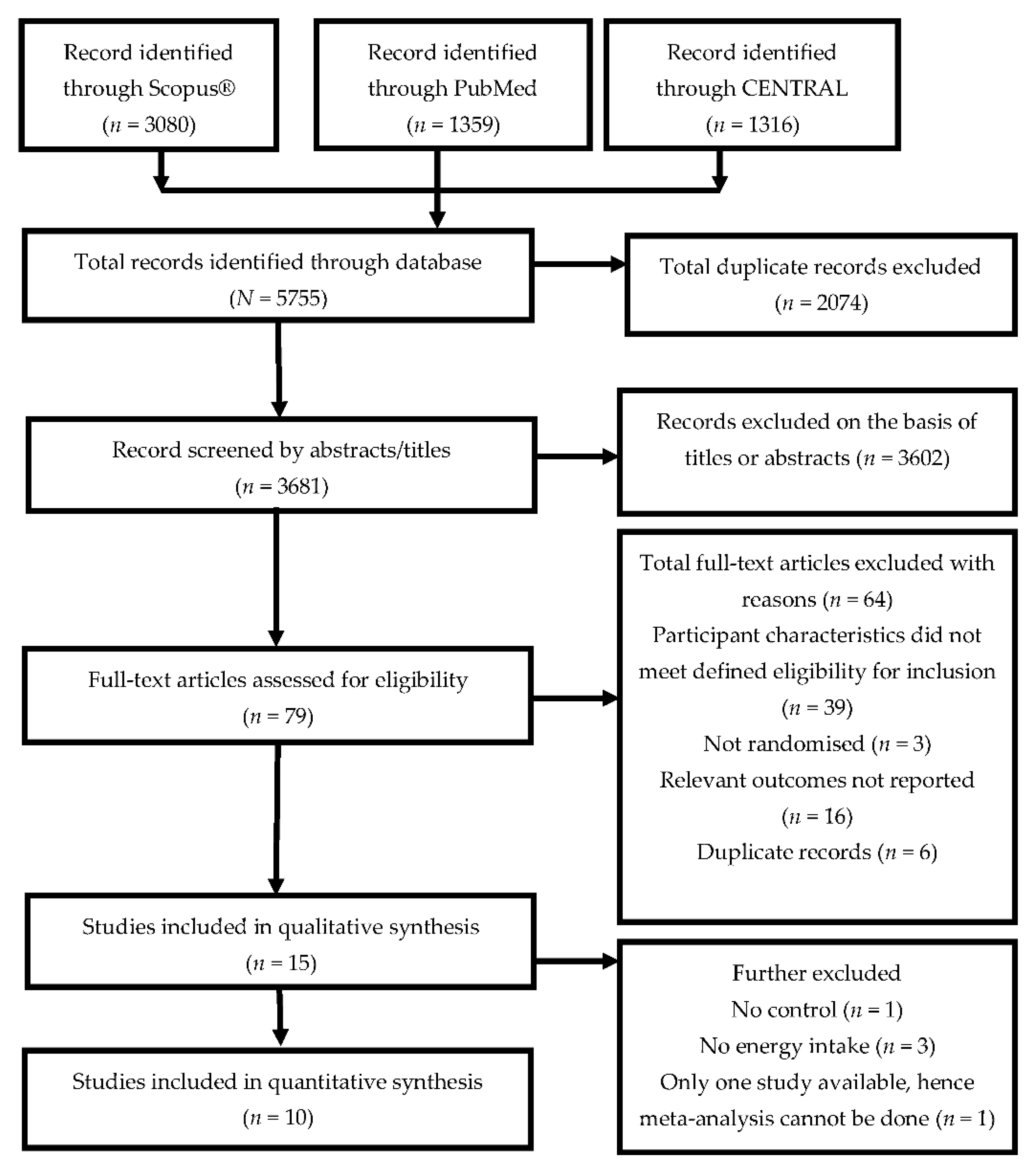
 Alginate
Alginate Pectin
Pectin Arabinoxylan
Arabinoxylan Polydextrose
Polydextrose Guar gum
Guar gum β-Glucan
β-Glucan High amylose maize
High amylose maize Polydextrose.
Polydextrose.
 Alginate
Alginate Pectin
Pectin Arabinoxylan
Arabinoxylan Polydextrose
Polydextrose Guar gum
Guar gum β-Glucan
β-Glucan High amylose maize
High amylose maize Polydextrose.
Polydextrose.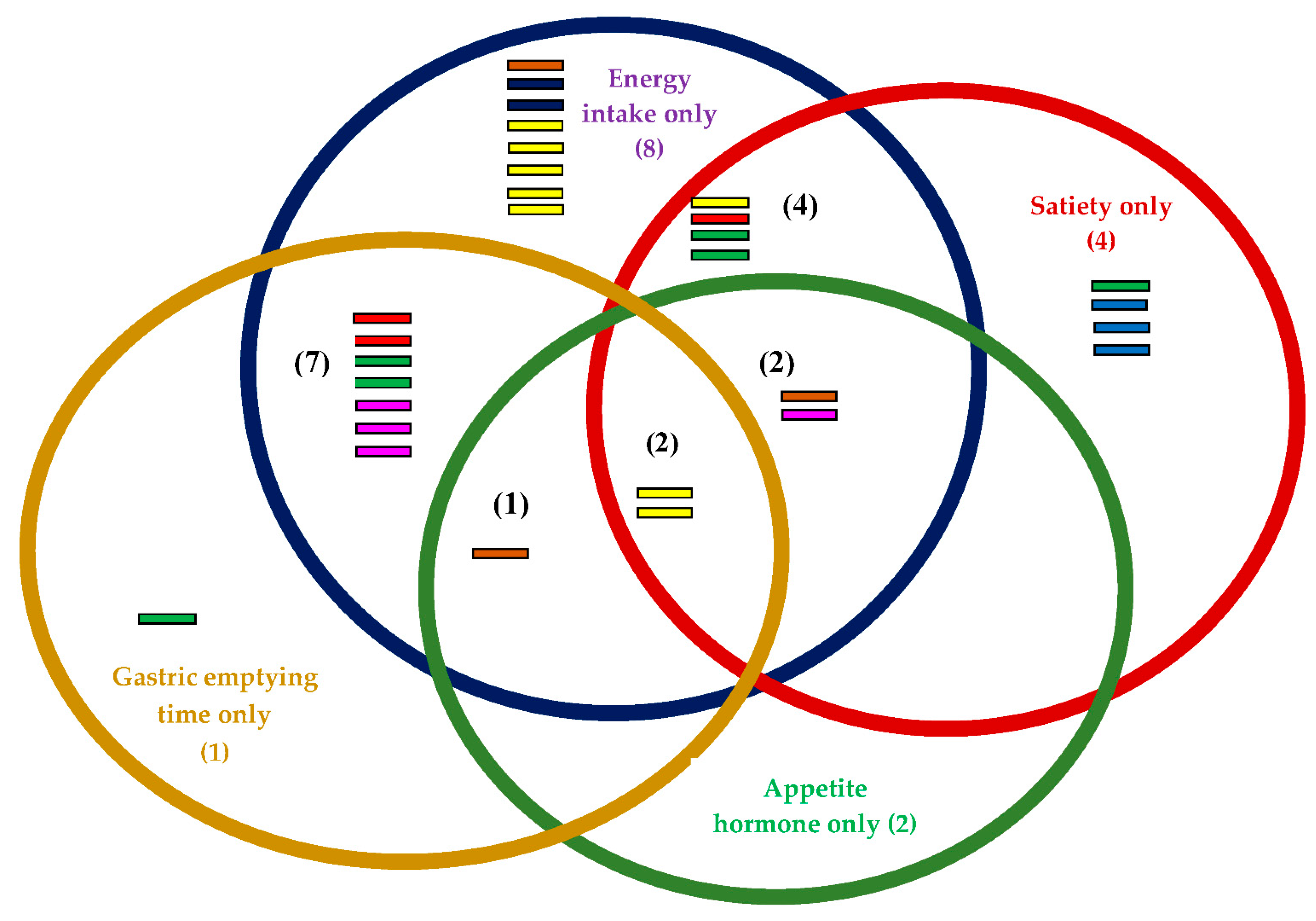
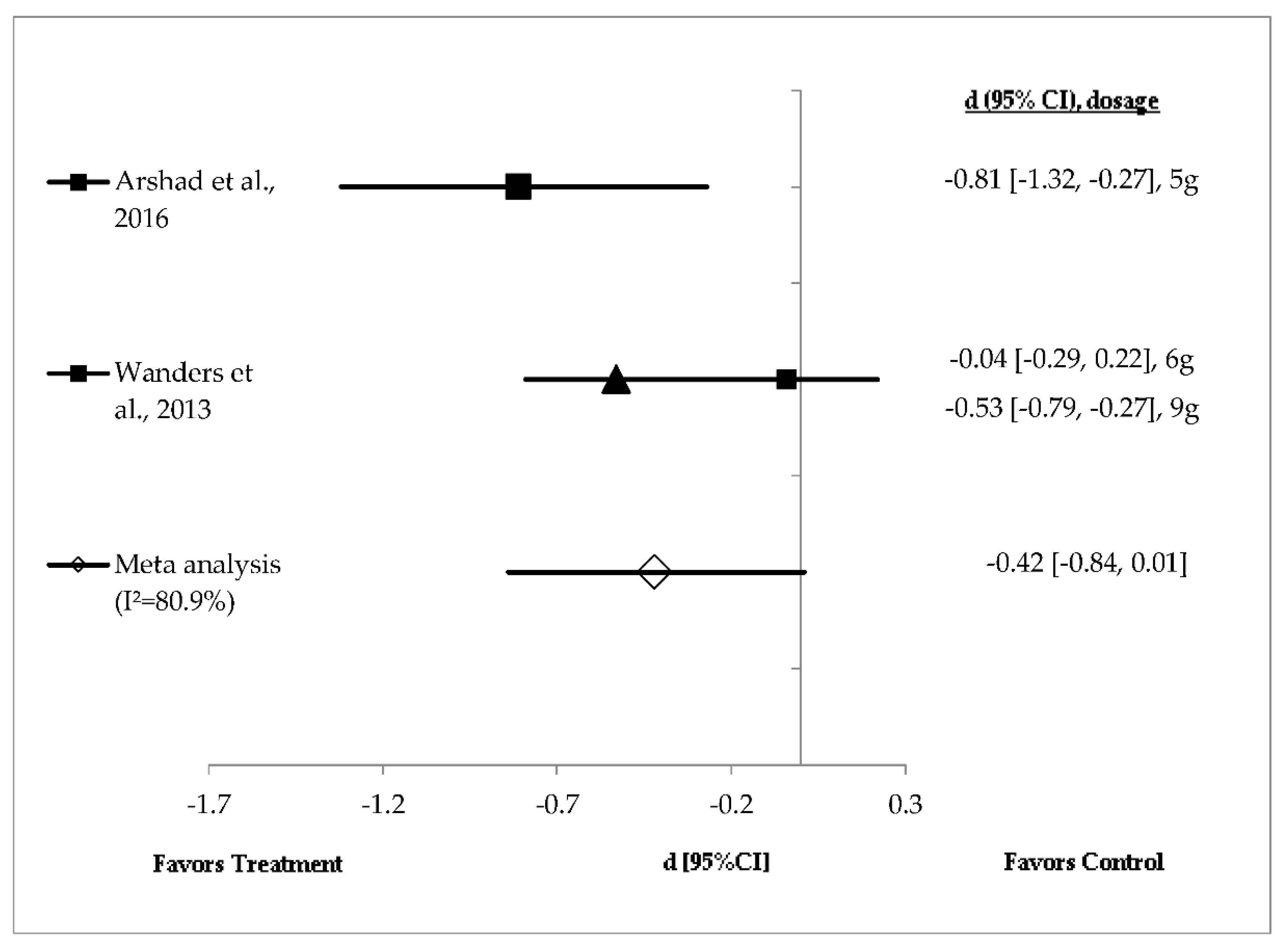
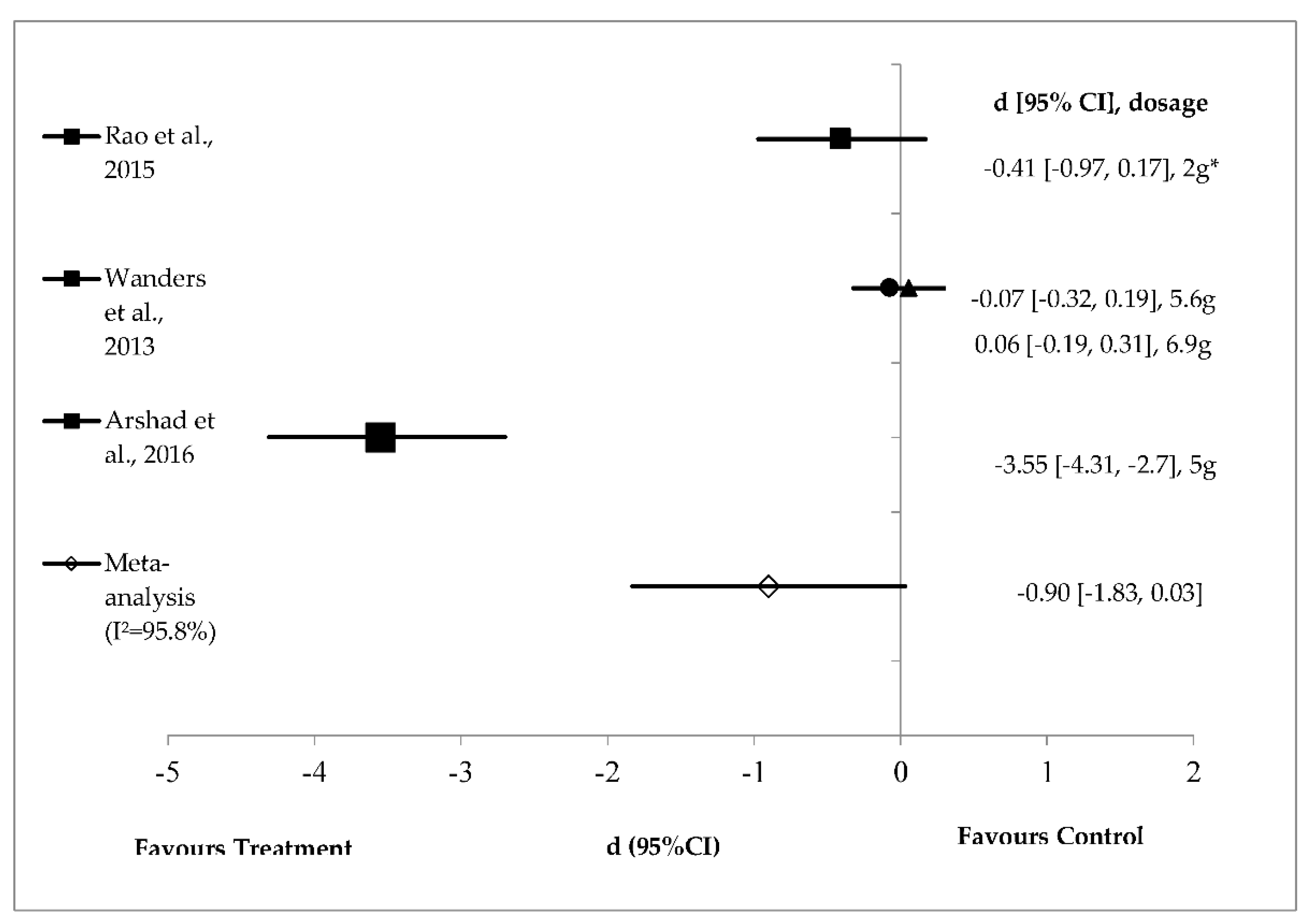
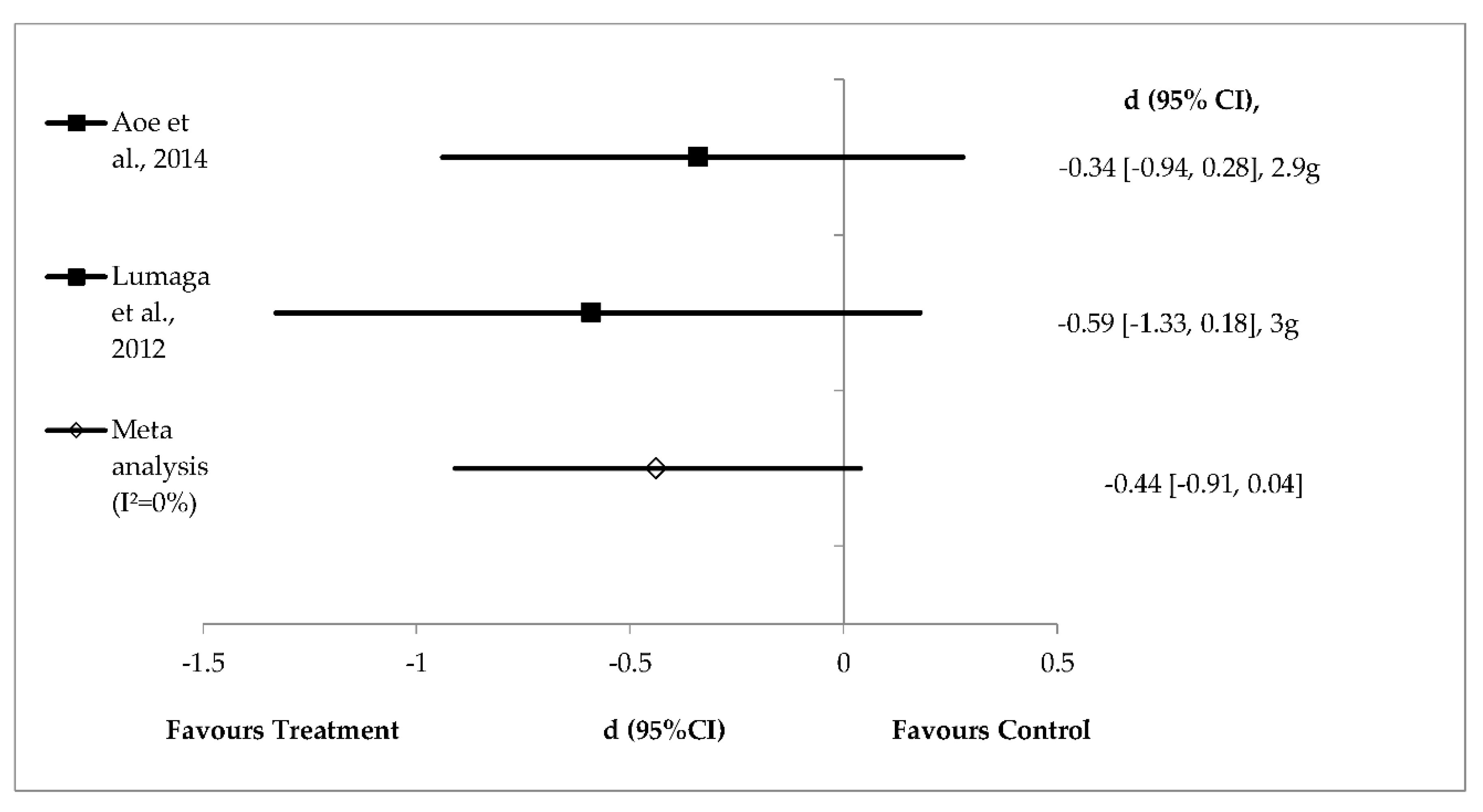
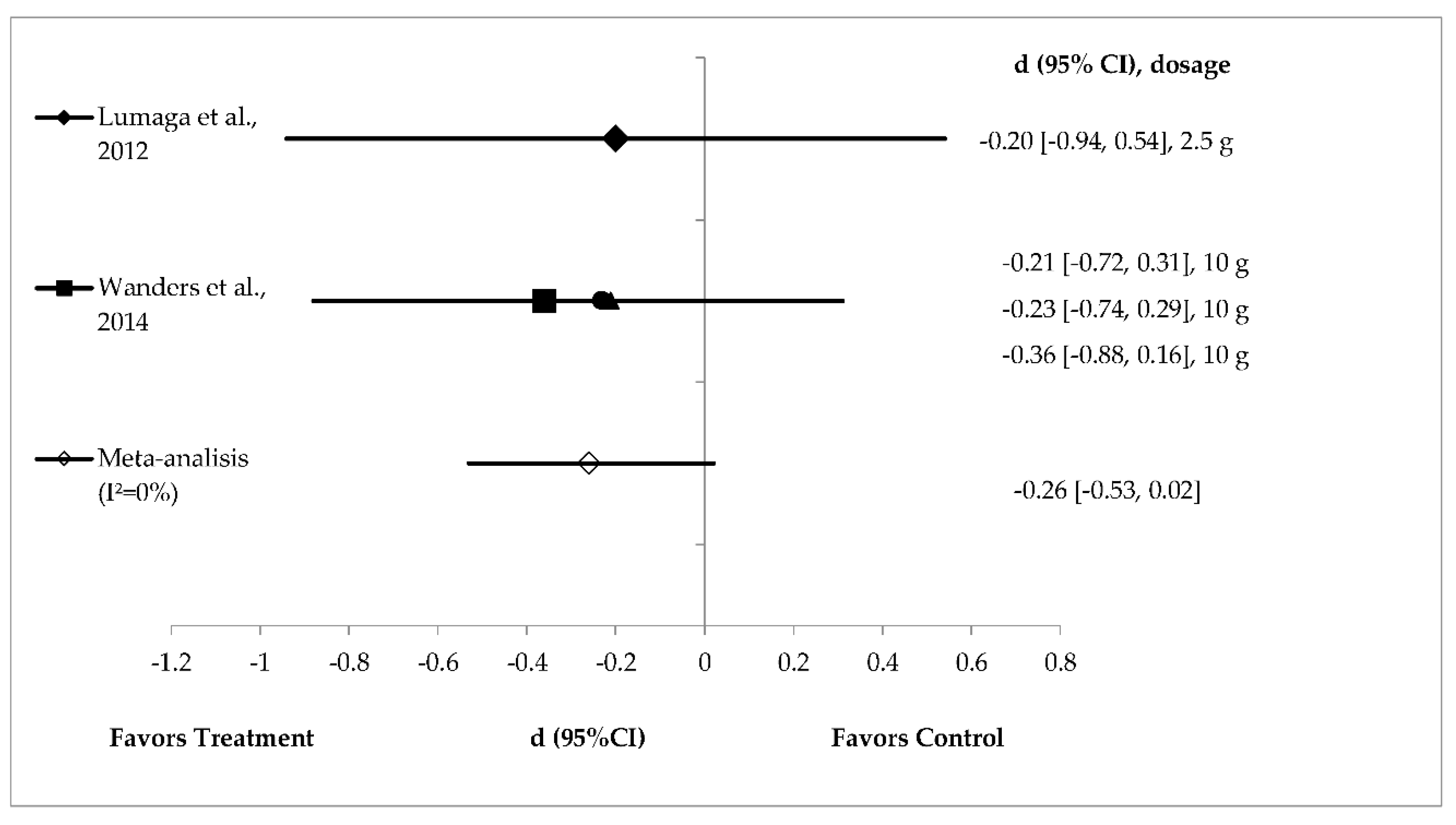
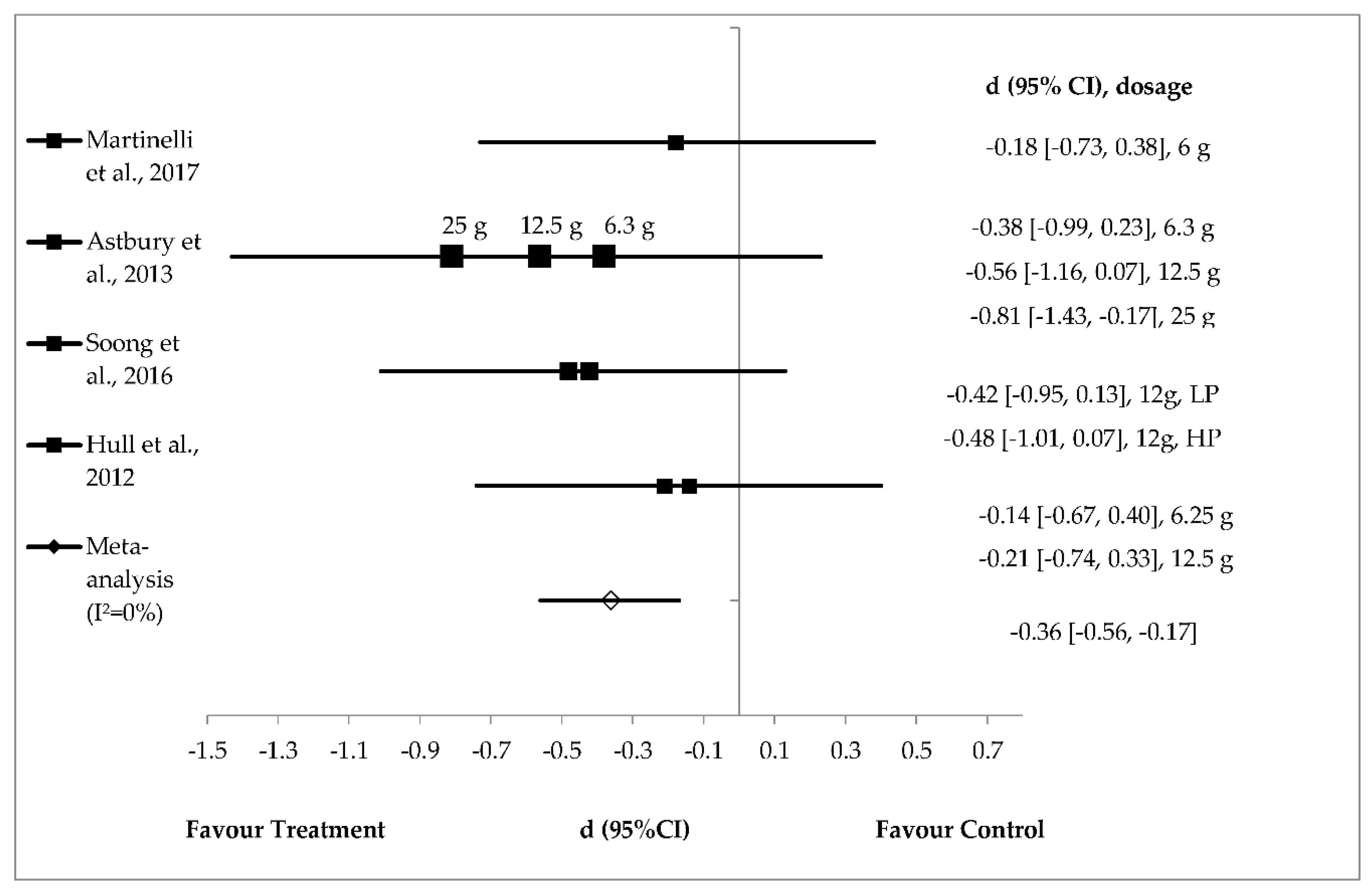
| Study | Fibre type | Dose | Study Overview | Appetite Hormone (Mean (SD)) (pmol·min/L) | Gastric Emptying Rate (min) | Energy Intake (kcal) | Perceived Satiety (Mean (SD)) (mm) |
|---|---|---|---|---|---|---|---|
| Arshad et al., 2016 [35] | Alginate | 5 g | Subjects: 30 (F: 18–30 y) Study design: randomised, single blinded Washout: 1-week Energy intake interval: 120 min Satiety: 170 min Food matrix: liquid (milk served chilled and iso-volumetric (250 mL) Control: milk (250 mL) without fibre | Data not available | Data not available | 611.76 (35.01) (p < 0.001) Effect size = −0.81 | 76.36 (1.82) (p < 0.05) Effect size = −0.90 |
| Guar gum | 5 g | Data not available | Data not available | 551.71 (23.52) (p < 0.001) Effect size = −3.55 | 61.81 (1.82) (p < 0.05) Effect size = −3.93 | ||
| Wanders et al., 2013 [36] | Alginate (MW: 60–1000 kDA) | (i) 6 g (ii) 9 g | Study 1 (energy intake): Subjects: 121 (45M/76F: 18–50 y) Study design: randomised, single blinded Washout: 2-day Energy intake interval: 105 min Food matrix: solid (400 g chocolate cookies with 500 mL of water) Control: chocolate cookies without fibre Study 2 (gastric emptying): Subjects: 10 (4F/ 6M: 18–50 y) Study design: randomised, single blinded Washout: 7-day Gastric emptying rate: every 15 min and up to 240 min Food matrix: solid (400 g chocolate cookies with 500 mL of water) Control: chocolate cookies without fibre | Data not available | Study 2: AUC, 13C breath used (i) 2126 (p < 0.05) (ii) 2145 (p < 0.01) No SD available to calculate effect size | Study 1: (i) 943.44 (406.04) (p = 0.77) Effect size = −0.04 (ii) 702.68 (429.92) (p < 0.001) Effect size = −0.52 | Data not available |
| Guar gum (MW: 17–710 kDA) | (i) 5.6 g (ii) 6.9 g | Data not available | Study 2: AUC, 13C breath used (i) 1918 (p > 0.05) (ii) 1864 (p > 0.05) No SD available to calculate effect size | Study 1: (i) 931.50 (501.58) (p = 0.63) Effect size = −0.07 (ii) 979.27 (525.46) (p = 0.66) Effect size = 0.06 | Data not available | ||
| Rao et al., 2015 [37] | Partially hydrolsed guar gum (PHGG) | Study 1: 2 g PHGG | Study 1 (breakfast, liquid yogurt): Subjects: 24 (12M/ 12F) Study design: randomised, double blinded Washout: 2-weeks Energy intake interval: 180 min Satiety: 240 min Food matrix: liquid (yogurt, 125 g) Control: Energy Intake: yogurt with dextrin Satiety: yogurt without fibre Study 2 (lunch, solid rice): Subjects: 6 (4M/ 2F) Study design: randomised, single blinded Washout: 2-days Satiety: 300 min Food matrix: solid (cooked rice) Control: cooked rice without fibre addition | Data not available | Data not available | Study 1: 731.60 (162.76) (p = 0.17) Effect size = −0.41 | Study 1 (breakfast, 2 g): 14.9 (15.19) (p < 0.05) Effect size = 0.46 |
| Study 2: 6 g PHGG | Data not available | Data not available | Data not available | Study 2 (lunch, 6 g): 22.8 (10.78) (p > 0.05) Effect size = 1.29 | |||
| Aoe et al., 2014 [38] | β-Glucan | 2.9 g | Subjects: 21 (F: 30–49 y) Study design: randomised, not-blinded Washout: 7-days Energy intake interval: 240 min Food matrix: solid (cooked white rice) Control: cooked white rice without fibre | Data not available | Data not available | 783.94 (147.47) (p = 0.28) Effect size = −0.34 | Data not available to calculate effect size |
| Lumagaet al., 2012 [39] | β-Glucan (viscosity = 55 mPas) | 3 g | Subjects: 14 (8M/ 4F:24–39 y) Study design: randomised, single blind Washout: 7-day Measurement of gut hormones: 180 min Energy intake interval: 180 min Satiety: 180 min Food matrix: liquid (250 mL beverages with isocaloric breakfast) Control: beverages without fibre | AUC: (pg·min/mL) (i) GLP-1: 1312.5 (467.71) (p > 0.05) Effect size = 0.18 PYY: 13125 (2806.24) (p > 0.05) Effect size = 0.13 GIP: 7000 (9354.14) (p > 0.05) Effect size = −0.11 | Data not available | 767.5 (246.2) (p = 0.13) Effect size = −0.59 | AUC (mm·min) 5400 (748.33) (p < 0.05) Effect size = 1.65 |
| Pectin (viscosity = 90 mPas) | 2.5 g | AUC: (pg·min/mL) (ii) GLP-1: 1125(62.5) (p > 0.05) Effect size = −0.18 PYY: 135,00 (5612.99) (p > 0.05) Effect size = 0.17 GIP: 6000 (3741.66) (p> 0.05) Effect size = −0.28 | Data not available | 871.2 (296.71) (p = 0.59) Effect size = −0.20 | AUC (mm·min) 6000 (1122.5) (p < 0.05) Effect size = 1.94 | ||
| Wanders et al., 2014 [40] | Pectin (different fibre forms) | 10 g (i) bulking (25 kDa) | Subjects: 29 M (18–30 y) Study design: randomised, single blinded Washout: 12-days Gastric emptying rate: 180 min Energy intake interval: 180 min Food matrix: dairy based liquid 150 mL Control: Different fibre formfor EI and GER: dairy based liquid without fibre Different supplementation methods: Gelled pectin in the form of capsule or liquid | Data not available | 13C recovery (i) 74.0 (20.4) min (p < 0.05) Effect size = 0.19 | (i)1058.09 (341.55) (p = 0.44) Effect size = −0.21 (bulking) | Data not available |
| 10 g (ii) viscous (80 kDa) | Data not available | 13C recovery (ii) 75.5 (21.0) min (p < 0.05) Effect size = 0.2 | (ii) 1058.091 (272.28) (p = 0.38) Effect size = −0.23 (viscous) | Data not available | |||
| 10g (iii) gelled (15 kDa) | Data not available | 13C recovery (iii) 82.2 (17.8) min (p < 0.05) Effect size = 0.65 | (iii) 1024.65 (238.85) (p = 0.17) Effect size = −0.36 (gelled) | Data not available | |||
| Different method supplementation (gelled pectin) | 10g (iv) capsule (15 kDa) | Data not available | 13C recovery (iv) 64.1 (21.9) (p < 0.05) Effect size = −0.91 | (iv) 955.38 (308.11) (p = 0.03) Effect size = −0.42 (capsule vs. liquid) | Data not available | ||
| 10g (v) liquid (15 kDa) | Data not available | 13C recovery (v) 98.3 (21.1) (p < 0.05) Effect size = 0.82 | Data not available | ||||
| Martinelli et al., 2017 [41] | Polydextrose | 6 g | Subjects: 25 (19F/ 6M:18–50 y) Study design: randomised, single blinded Washout: 7-days Energy intake interval: 240 min Satiety: 30 to 240 min Food matrix: composite meal (100 g pudding with 200 mL semi-skimmed milk) Control: Pudding without fibre | Data not available | Data not available | 1021.27 (356.60) (p = 0.53) Effect size = −0.18 | iAUC (mm·min) 5166.67 (666.67) (p = 0.934) Effect size = −0.27 |
| Astbury et al., 2013 [42] | Polydextrose | (i) 6.3 g | Subjects: 21 (12M/ 9F) Study design: randomised, single blinded Washout: 1-week Energy intake interval: 90 min Food matrix: liquid (chocolate-flavoured liquid, 400 mL) Control: chocolate-flavoured liquid, 400 mL without fibre | Data not available | Data not available | (i) 1206.5 (420.58) (p = 0.22) Effect size = −0.38 | Data not available |
| (ii) 12.5 g | Data not available | Data not available | (ii) 1128.59 (421.58) (p = 0.08) Effect size = −0.56 | Data not available | |||
| (iii) 25 g | Data not available | Data not available | (iii) 1042.54 (346.10) (p = 0.01) Effect size = −0.81 | Data not available | |||
| Soong et al., 2016 [43] | Polydextrose | 12 g (i) low protein | Subjects: 27 (M: 21–40 y) Study design: randomised, single blind Washout: 5-day GLP-1 hormone: 90 min Gastric emptying rate: 90 min Energy intake interval: 180 min Satiety: 75 min Food matrix: solid (soya bean curd) Control: soya bean curd without fibre | GLP-1: (n=15) (i) 338.97 (484.63) (p < 0.05) Effect size = 0.18 | (i) 0.26 (0.14) min (p = 0.05) Effect size = −0.47 | (i) 790.71 (231.73) (p = 0.13) Effect size= −0.42 | iAUC (mm·min) (i) 1892.44 (1570.33) (p > 0.05) Effect size = −0.05 |
| 12 g (ii) high protein | GLP-1: (n=15) (ii) 625.59 (776.77) (p < 0.05) Effect size = 0.60 | (ii) 0.18 (0.17) min (p < 0.05) Effect size = −0.72 | (ii) 774.21 (242.86) (p = 0.08) Effect size=−0.48 | iAUC (mm·min) (ii) 1809.11 (1402.49) (p > 0.05) Effect size = −0.11 | |||
| Hull, et al., 2012 [44] | Polydextrose | (i) 6.25 g | Subjects: 34 (10M/ 24F) Study design: randomized, crossover, single blind Washout: 1-week Energy intake interval: 90 min Food matrix: liquid (drinking yogurt) Control: drinking yogurt with glucose syrup | Data not available | Data not available | (i) 731.36 (228.56) (p = 0.61) Effect size = −0.14 | Data not available to calculate effect size |
| (ii) 12.5 g | Data not available | Data not available | (ii) 711.52 (263.40) (p = 0.44) Effect size = −0.21 | Data not available to calculate effect size | |||
| Juvonenet al., 2009 [45] | β-Glucan | (i) High viscosity (10 g) (>3000 mPas) | Subjects: 20 (16F/ 4M) Study design: randomized, single blinded Washout: > 2-days Measurement of gut hormones: 180 min Gastric emptying rate: 90 min Energy intake interval:180 min Food matrix: liquid (300mL isoenergy and isovolumetric beverage with 200mL water *Low viscosity acts as control | GLP-1 (AUC): (pg·min/mL) (i) 74 (89.44) (ii) 189 (214.66) (p = 0.030) Effect size = −0.70 PYY (AUC): (i) 129 (720.01) (ii) 668 (822.87) (p = 0.038) Effect size = −0.70 CCK (AUC): n=17 (i) 250 (181.42) (ii) 449 (300.99) (p = 0.006) Effect size = −1.78 | Paracetamol AUC (*n = 10) (i) 14670 (3443.55) (μmol·min/L) (ii) 16340 (5567.81) (μmol·min/L) (p = 0.051) Effect size = −0.36 | Combined (preload + rest of the day) (i) 1733 (113.05) (ii) 2007.89 (154.16) (p = 0.026) Effect size = −2.03 | Data not available |
| (ii) Low viscosity (10 g) (<250 mPas) *Differed only in viscosity | |||||||
| Boll et al., 2015 [46] | (i) AXOS, 8.9 g | Subjects: 19 (9M/ 10F: 20–35 y) Study design: randomised, not blinded Washout: 1-week GLP-1: acute (180 min) Food matrix: solid (white wheat bread with 250–300 mL water) Control: white wheat bread without fibre | GLP-1: (i) 1.01 (0.92) (p > 0.05) Effect size = 0.10 | Data not available | Data not available | Data not available | |
| (ii) hiAXOS, 18.4 g | GLP-1: (ii) 1.04 (0.92) (p > 0.05) Effect size = 0.19 | Data not available | Data not available | Data not available | |||
| Thazhath et al., 2014 [47] | Guar gum MW: 220 kDa | 9 g | Subjects: 12 (6M/ 6F) Study design: randomized, crossover, not blinded Washout: 5-day Gastric emptying rate: every 5 min for 1st hour and every 15 min for further 3 h (240 min) Food matrix: semisolid (mashed potato, 300 mL) Control: semisolid mashed potato 300 mL without fibre | Data not available | 13C2 breath used 285 (93.53) (p < 0.05) Effect size = 1.02 | Data not available | Data not available |
| Luhovyy et al., 2014 [48] | High-amylose maize | (i) 17.5 g | Subjects: 30M (18–30 y) Study design: randomized, crossover, single blinded Washout: 1-week Energy intake interval: 120 min Food matrix: solid (cookies) Control: cookies without fibre | Data not available | Data not available | (i) 1163.9 (279.34) (p = 0.99) Effect size = 0.00 | Data not available |
| (ii) 31.5 g | Data not available | Data not available | (ii) 1147.5 (310.56) (p = 0.83) effect size = −0.05 | Data not available | |||
| Solah et al., 2014 [48] | PolyGlycopleX (PGX®) | (i) 2.5 g | Subjects: 10 (20–29 y) Study design: randomised, single blind Washout: 2 or 3 days Satiety: 120 min Food matrix: liquid (water, 2 × 250 mL) Control: inulin in 500 mL water | Data not available | Data not available | Data not available | iAUC (mm·min) (i) 3501 (2070) (p < 0.05) Effect size = 0.56 |
| (ii) 5 g | Data not available | Data not available | Data not available | (ii) 2937 (1750) mm·min (p > 0.05) Effect size = 0.32 | |||
| (iii) 7.5 g | Data not available | Data not available | Data not available | (iii)3942 (2250) mm·min (p < 0.05) Effect size = 0.74 |
| Studies | Randomisation | Double-Blinding | Withdrawals and Drop-Outs | Score | |
|---|---|---|---|---|---|
| Arshad et al., 2016 [35] | 1 | 0 | 1 | 2 | |
| Wanders et al., 2013 [36] | Study 1 | 1 | 0 | 1 | 2 |
| Study 2 | 1 | 0 | 1 | 2 | |
| Rao et al., 2015 [37] * | Study 1 | 1 | 1 | 1 | 3 |
| Study 2 | 1 | 0 | 1 | 2 | |
| Aoe et al., 2014 [38] | 1 | 0 | 1 | 2 | |
| Lumaga et al., 2012 [39] | 1 | 0 | 1 | 2 | |
| Wanders et al., 2014 [40] | 2 | 0 | 1 | 3 | |
| Martinelli et al., 2017 [41] | 1 | 0 | 1 | 2 | |
| Astbury et al., 2013 [42] | 2 | 0 | 1 | 3 | |
| Soong et al., 2016 [43] | 2 | 0 | 1 | 3 | |
| Hull, et al., 2012 [44] | 1 | 0 | 1 | 2 | |
| Juvonen et al., 2009 [45] | 1 | 0 | 1 | 2 | |
| Boll et al., 2015 [46] | 1 | 0 | 1 | 2 | |
| Thazhath et al., 2014 [47] | 1 | 0 | 1 | 2 | |
| Luhovyy et al., 2014 [48] | 1 | 0 | 1 | 2 | |
| Solah et al., 2014 [48] | 2 | 0 | 1 | 3 |
© 2019 by the authors. Licensee MDPI, Basel, Switzerland. This article is an open access article distributed under the terms and conditions of the Creative Commons Attribution (CC BY) license (http://creativecommons.org/licenses/by/4.0/).
Share and Cite
Salleh, S.N.; Fairus, A.A.H.; Zahary, M.N.; Bhaskar Raj, N.; Mhd Jalil, A.M. Unravelling the Effects of Soluble Dietary Fibre Supplementation on Energy Intake and Perceived Satiety in Healthy Adults: Evidence from Systematic Review and Meta-Analysis of Randomised-Controlled Trials. Foods 2019, 8, 15. https://doi.org/10.3390/foods8010015
Salleh SN, Fairus AAH, Zahary MN, Bhaskar Raj N, Mhd Jalil AM. Unravelling the Effects of Soluble Dietary Fibre Supplementation on Energy Intake and Perceived Satiety in Healthy Adults: Evidence from Systematic Review and Meta-Analysis of Randomised-Controlled Trials. Foods. 2019; 8(1):15. https://doi.org/10.3390/foods8010015
Chicago/Turabian StyleSalleh, Siti Nurshabani, Ahmad Adli Hamizi Fairus, Mohd Nizam Zahary, Naresh Bhaskar Raj, and Abbe Maleyki Mhd Jalil. 2019. "Unravelling the Effects of Soluble Dietary Fibre Supplementation on Energy Intake and Perceived Satiety in Healthy Adults: Evidence from Systematic Review and Meta-Analysis of Randomised-Controlled Trials" Foods 8, no. 1: 15. https://doi.org/10.3390/foods8010015
APA StyleSalleh, S. N., Fairus, A. A. H., Zahary, M. N., Bhaskar Raj, N., & Mhd Jalil, A. M. (2019). Unravelling the Effects of Soluble Dietary Fibre Supplementation on Energy Intake and Perceived Satiety in Healthy Adults: Evidence from Systematic Review and Meta-Analysis of Randomised-Controlled Trials. Foods, 8(1), 15. https://doi.org/10.3390/foods8010015





